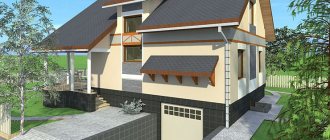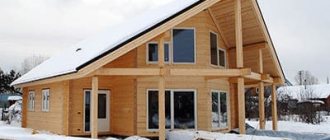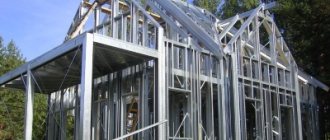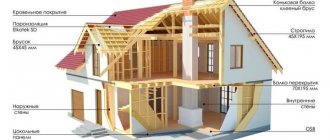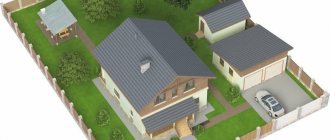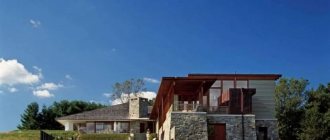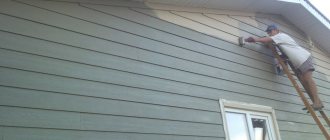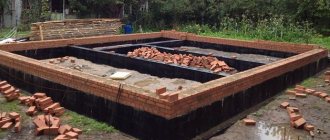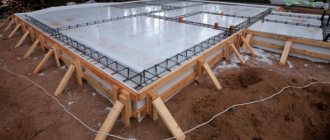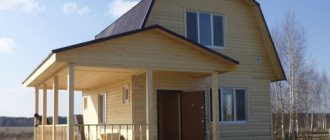Severity of style, originality, functionality at the same time
Due to natural conservatism, each of us tries not to stand out, we are afraid of being branded as a black sheep.
This applies to construction and architectural claims. And at the same time, would anyone refuse to erect an unusual, beautiful and functional structure, near which people would slow down, amazed at the boldness of the forms and the severity of the taste? Numerous construction forums are replete with questions from uninitiated beginners and detailed discussions from experienced gurus about the new round of frame construction fashion for six- and octagonal houses that came from Norway. Surprisingly, the optionality of such an obtuse-angled structure turns out to be higher than the usual parallelepiped.
The benefits are obvious:
- Significant savings in material on walls;
- Reducing the building area;
- Reducing the weight of the structure, easing pressure on the foundation;
- Reduced heat loss and wind load.
But changing the geometry of the interface between walls and the rafter system will require greater professionalism and responsibility of the developer or hired team. However, the game is worth the candle; more technically complex log buildings of worship are still pleasing to the eye to this day. The apparent airiness of the fortress and temple octahedra deceives the eye - visually they are much smaller than in reality.
Towards the evening of the day we moved into the hut, a snowstorm began. We lit the stove, turned on the light, sat among a pile of bags and trunks and were glad that the construction ended on time. The only furniture in the house was a table, a bench and a bed, and there was still a lot of minor finishing work to be done, but most of the construction was already behind us. In addition to the size of the house, the timing of construction was also quite impressive. Despite the almost three-week delay in leaving the village, despite some technical hiccups, Bure alone (!!!) managed to build our warm winter hut before the frosts. In three weeks. I have no help in the construction, considering the children. I mostly sat in the tent and brewed buckets of mint tea for our builder)))
So, we reached the lake already in the evening twilight on September 6th. In the morning, Bure and Afanas unloaded the Ural and went to cut down the forest. As it turned out, there was literally nothing to knock down. The mountain river, with which our lake is connected by a channel, carries away many trees from year to year with stormy spring water (or after heavy rains). Due to the layer of permafrost, which in these parts reaches almost to the surface of the earth, the roots of trees grow shallowly, no more than half a meter, but they grow in width. But if the soil softens, nothing can keep twenty- or even thirty-meter trees on the wrong soil. The guys consulted and decided to use driftwood with a noble silvery coating and windfall, which was piled up by hurricane winds this summer, for construction. This turned out to be a plus - more than half of the harvested logs had already been sanded by the river itself. Bure was very happy that he did not have to cut down those tall, beautiful trees that had been growing along the banks of the lake and river for hundreds of years.
It took several days to prepare the required amount of building materials, and already on the tenth, Bure began construction. Afanas was pressed for time - he only took a few days off from work, and he needed to return to the village as soon as possible.
Bure, stocking up on gasoline, began to build. A long time ago, a hexagonal house was planned; the first crown was the three heaviest logs. Logs of three and a half meters, which are, of course, more convenient to carry in one person than four-meter logs. The driftwood is generally quite heavy, as it gradually becomes saturated with water. Until about the third crown, the logs were literally too heavy to lift, so Bure threw them onto the wall using a whole system of weights and logs. Moss was laid between the logs, about a bag for two logs, fortunately, there are no problems with moss in the taiga. Then, when the walls were raised, I at least caulked the walls again, starting from the northern side, since I had already learned - on Solbokar, by the time I reached the northern wall, frosts had struck, the wet moss between the logs had frozen into an icy impenetrable crust , and our entire northern wall was terribly cold then.
The weather was changing. Sometimes there was a drizzling rain, sometimes the snow fell and melted, the winds blew, fraying the golden decoration from the larches. The house grew. At some point, the chainsaw stalled, and Bure, in order not to lose momentum, switched to an ax and a saw, gratefully remembering the men who taught him to build with an ax as a teenager.
The walls rose. The inner wall was three meters long. Six walls of three meters each. This is gorgeous, guys))) The height of the wall is about one and a half meters, and then the roof goes up. Very free. The windows were laid out on the south and southeast sides, the door was located in the northeast. What was unexpectedly pleasant was that in the hexagonal room the light spreads a little differently, and with three windows we ended up with such a bright room that neither a fairy tale nor a pen could describe it.
One day Bure laid down logs that became the basis for the roof.
Next, boards were laid, on top of roofing felt, and a layer of turf. Bure was in a great hurry to dig up the turf before the frosts, because there is nothing worse than digging and picking at frozen turf with hands already cracked from fishing in the cold wind. But we were lucky - the weather was sunny, Bure cut squares of about 50x100 cm with a shovel, and it took almost 60 of these rectangles for our entire roof. When the roof was ready, Bure installed a brick stove (yes, we brought two hundred more bricks with us! By the way, local, Sasyr production, however, from the times of the USSR), the stove is offset from the center so that on one side it turns out to be a cozy nook, there we have a “bedroom”, and on the other side there is a spacious hall, bright and with a high (two eighty!!!) ceiling.
The stove dried out for several days, then I whitewashed it, it became light and elegant. By the way, an oven was installed in the stove, which was also brought from the village. I haven’t baked anything in it yet, but as soon as I try it, I’ll tell you right away.)))
Next came the turn of the windows. The first window was made in the same way with an axe, and by the second window the chainsaw suddenly came to life, and things went faster. The windows are also lined with moss, and in October or November Afanas will bring more glass to make double panes even warmer.
The floorboards, sawn and planed, also came with us from the village. The floor was two levels, the hallway was lower, the living room was higher. This is good, because my son actively crawls, lives on the floor, and we needed a warm floor. By the way, the floor level was measured with a camera. Nice feature, glad it finally found a use)))
And finally, the door. The door turned out to be authentic. It so happened that we forgot the door hinges, and we had to remember the experience of our ancestors, so to speak. We saw a similar door fastening in the Yakut Khoton Museum on the Bayaga River. A very good decision! After the move, the door was covered with skins inside and out, I’ll show you this a little later, when we’ve finished sorting things out, finishing the shelves, every little thing, putting things in order, and we can show off the interior.
I receive many letters with questions about projects, construction and operation. Many people throughout the former USSR liked it, and people appeared who wanted to build one for themselves.
Sergey from Kyiv writes:
“Good day!
I'm shocked!))) I'm going to build a hexagonal house, similar to yours!
And then I find your project.) I didn’t find your e-mail... I would like to write to you, discuss, there are many questions” Oksana from Siberia writes:
"Sergey! We have a similar situation, we are thinking about the layout of the hexagon, I hope in the summer we will do the foundation. Please send me your sketches by email, if it’s not difficult.”
Nikita from Estonia writes:
“Hello, Sergey! This is simply the materialization of some kind of sensual ideas. I have planned a house for myself, but I don’t have money for expensive architects, and I don’t want an ordinary box house. I’ve been drawing the idea of a hexagon for six months now, so I decided to google it in a search and the first link to your project, and even with detailed drawings, thank you!”
Dmitry from Yekaterinburg writes:
“Sergey, I really liked your project, its simplicity and at the same time originality are very captivating. You will allow us to use your project, and we will tell all our friends that this is the project of Sergei Ozerny from Belarus :-)))))"
Sergey from Kyiv shared his vision of a hexagonal house and sent sketches, which I publish with my comments.
Initially, Sergei wrote to me that he plans to provide daylight to the attic through “dormer windows.” Frankly, I was skeptical about this idea, because I really don’t like “chicken coops” sticking out to the sides from the roof plane. Nevertheless, when I saw these sketches, I agreed that this option has the right to life and looks decent.
But it seems to me that three small windows, as shown, will not be enough. Making a dormer window in each slope is probably not the best option; it will look too “overloaded.” In my opinion, there are two solutions, the first is to make continuous glazing of the dormer window, i.e. a triangular-shaped window, this will significantly increase the window area and will look beautiful in the dark, emphasizing the original silhouette and the very idea of the house. The second option can be combined with the first - add Velux roof windows to the three free slopes. Dormer windows are very nice and romantic in themselves. Sleeping under such a window, watching raindrops or snowflakes fall on you, seeing the starry sky above you on a clear night, and all this without getting out of bed... What could be more romantic?
The next two problematic elements are the porch and gazebo/canopy. In the form they are in the sketches, they completely kill the entire project. Any extensions, attachments, porches and awnings that are not architecturally and structurally connected with the main structure look extremely poor.
I propose the following solution for the porch - extend part of the roof plane downwards (above the door) in the form. Such a solution will be fully functional, i.e. will serve as a canopy over the porch; it will not kill the house, but, on the contrary, will emphasize all the advantages of this project.
The same situation is with the gazebo/canopy - you need to extend the plane of the roof slope downwards. You need to draw different shapes and choose the most aesthetically acceptable one. You can simply extend the slope downwards, maintaining the general shape of a regular triangle, you can mirror the triangle downwards, you will get an irregular rhombus, you can choose some kind of angular asymmetrical shape, but always in the same plane with the main slope of the roof.
There is one more disadvantage - “two pipes”. We must try to fit all the chimneys and ventilation ducts required by the house into “one pipe”; usually this is not an easy task, but today there are a lot of flexible, rigid, elbow and other types of ventilation ducts and chimneys. If, due to the layout, it is not possible to get by with just one pipe, you still need to try to minimize aesthetic losses.
I don’t comment on the internal layout; here everyone decides for himself what is more convenient, comfortable and attractive for him. In Sergei’s version, I like the attic floor - a single spacious room. But, in connection with the layout of the first floor, the question arises - where will the children live, and if they are not planned, then where will the guests stay overnight?
The composition of the hexagon house project
includes the following materials: facade, sections, explication of premises, plan of the first and second floors, etc.
The project of a hexagon house presented to your attention
is an interesting architectural solution for the construction of a two-story house made of processed logs. This log house is especially attractive due to its original hexagonal shape. This, of course, is an awesome feature in assessing the exterior - such a house will be the center of attention in any place where it is built. Judge for yourself, how many hexagonal houses are being built here? That's right, very little, respectively, this fact is another reason to take a closer look at this hexagonal house project.
If we talk about the layout of this two-story hexagonal house
, then it is worth noting that it is also extremely unusual, like the house itself. Moreover, the house is equipped with all the necessary premises. On the ground floor of the hexagonal house there is a living room, a kitchen combined with a dining room, three bedrooms, a master's office, a bathroom, a corridor, and a storage room. The second floor has four bedrooms, a gallery and a balcony.
However, what is interesting is how these rooms are located - in such a house there is its own reality - the expression - sitting within four walls is no longer relevant here.
In general, when you download the hexagon house project
, then see for yourself.
On a hill in a cozy American town there is a small chalet with a unique hexagonal shape. The house is extremely atypical for these places. The idea for the building was born during a trip to North America. During a day trip, Rene Squindo and his girlfriend stayed overnight in a small private hotel, the building of which was built from a log frame. The couple liked it there so much that they decided to build a similar house for themselves. The hexagonal shape was not chosen by chance. According to the owner, the young baker Rene, this shape, similar to a honeycomb, is best suited for building a house, because Mother Nature herself created it. The building materials used in the construction process had to be as natural and environmentally friendly as possible. Now these technologies are incredibly popular and turnkey houses made of timber are being built all over the world - houses, turnkey bathhouses, cottages made of timber, all using the latest technologies, in a short time and at a reasonable price. In this case, the design can be anything, this is already discussed in detail with the building contractor.
The hexagon design requires more costs, unlike the usual one. For a house of this shape, logs of much greater length are needed, and the process of making one cut (corner joint) at a right angle is much cheaper than making a log house with an angle of 60°. In total, a little more than 750 thousand dollars were spent on the construction of the chalet. Despite this, the design has a number of advantages. In this house, the walls are not located directly against the slope, which allows light to easily penetrate the windows.
From the outside the chalet may seem quite small. In fact, there is a lot of space inside: the basement floor alone, measuring 130, can accommodate four cars. On the ground floor there is a guest room, a guest bathroom, an office and a storage room, as well as a huge studio room, which combines the functions of a living room, kitchen and dining room. A gallery, two bedrooms and a bathroom fit perfectly on the top floor.
The design of the premises deserves special attention. The owners wanted to move away from the classic interior of a farmhouse. The decorative elements here include a wide variety of items: a baby stroller from the mid-20th century, a very rare “Route 666” watch, and even a rare gas pump from North America in working condition. To soften the “log-house” style, the walls of the rear rooms were painted white and the floors were laid with black granite. Adding contrast to the usual farmhouse look is an ornate steel spiral staircase, a modern breakfast bar in the kitchen, and a royal blue armchair.
Order a project
For the construction of a tetrahedral frame house, the project is desirable, for an octagonal one it is mandatory. The most serious difficulties will arise with the roof and rafter system. Depending on the building area, you will either have to support the rafters only on load-bearing walls, or additionally build a multifunctional support center that will also support the interfloor floors.
Availability of specifications and working drawings of complex interfaces will help to avoid unnecessary errors and waste of materials.
Designers often offer a three-dimensional image of an object - do not refuse this service. Provided that the proportions are respected, your house, instead of being heavy, will have the ease of floating above the landscape. The volume conceals the tendency upward, towards the center of the hipped roof. Sometimes an accurate scale sketch is enough.
Minimum things - maximum freedom
Tim is 30 years old, his wife Sam is 28, they have been living in a beautiful place for three years - on a 6 km2 peninsula in Sarasota (Florida). Initially, they settled in an ordinary house, like everyone else, but then they brought a tiny octagonal house there from the mainland and moved into it. This was their long-time dream, however, they had to radically change their lives.
The couple got rid of 80% of their belongings to move into a mini-house. It turned out that we can do very well without a lot of things that we consider obligatory in our lives. The young people left only the essentials - a bed, a TV, a table and kitchen utensils. A suitcase even serves as a bedside table, and the lamps are built into the walls so as not to take up extra space.
Tim says, “Moving into a tiny house has given us so much mental and financial freedom! We were able to use the money we would have had to use for a mortgage on trips to places like Cuba and South Africa and invest in our retirement. We have dreamed for so many years to get this freedom! I can’t imagine ever wanting to change our way of life.”
Contact lenses developed to correct color blindness
Marine Wildlife Center volunteer from Wales finds ball lost in Ireland
The baby's face immediately changes as soon as he sees his favorite presenter (video)
Foundation
A columnar foundation with the obligatory addition of a gravel-sand mixture to the base is preferable. With an advantageous high base, which allows you to overcome the natural squatness, it becomes possible to make the cover of the base from lightweight materials, and use polystyrene foam from the inside as insulation.
Additionally, we are purchasing a semi-basement floor, which can be used as a warm garage, workshop and as utility rooms for other purposes. Additional support under the geometric center is desirable even with a small floor area - in order to avoid sagging of the lower frame.
Plan of a two-story octagonal house 12x12
This project was created for brave people who do not choose standard solutions! The house's octagonal plan is already unusual, and the layout challenges designers. In the center of the house there is an office with a fireplace, located a couple of steps below the main floor. The office has high ceilings with second-light windows. The remaining rooms are located around the study, starting from the living room, located next to the built-in terrace, and ending with the master bedroom with access to the terrace.
Great house
Living room
Back view
Option with stove
What difficulties await you with insulation?
Regardless of the design features, the construction stages of a conventional frame house are completely preserved. The fundamental difference is in the geometric component. First of all, this concerns insulation. With traditional mineral wool you won't have any headaches. There will be a lot of cutting and joining. Floors are the most difficult area. The radial divergence of the joists and rafters will incredibly complicate the uniform filling of the insulator. Walls tapering inward will add their own problems.
Filled foam-forming thermal insulation breathable reagents will help to significantly speed up the insulation process. For a frame house, the passive removal of condensing moisture from the wall filler is extremely important to preserve the thermophysical properties. Therefore, it is preferable to use well-proven penoizol - this insulation does not lose its physical properties throughout the life of the home and conscientiously removes moisture due to its porous structure.
Central support
With a floor area of a frame house over 50 sq. m installation of a central support is required. In addition to supporting the strapping, it will become the unloading axis of the rafter system of the roof dome. There are good examples of pushing the boundaries of loaded axle use. The material of manufacture is not regulated, but if you plan to use a stove or fireplace, then, definitely, brick.
Exhaust ventilation and a chimney are adjacent to it. It will also serve as a support for the stairs. Being the natural geometric middle of the room, it divides it into zones.
It is worth using your imagination so that the internal vertical carries the semantic load of the core of the house, not only dividing, but also simultaneously uniting living spaces.
Interior design – the standard of minimalism
The miniature home has a custom 1920s style with a tiled shower room and sink, as seen in the photo. The couple named their house "Tiffany".
Tim says: “Tiny houses are very affordable for those looking to buy their first home. "You can get a fully equipped home for as little as $20,000 to $30,000, or even $10,000 if you don't care about the bathroom."
Sam added: “The tiny house is also very durable. The Tiffany is not hurricane resistant, but it has already survived a major storm. Sometimes it can be a little challenging to host guests, but we are resourceful. If friends come over, they sit at the counter, and we sit on the stairs.”
And no greenhouse is needed: we stock up on disposable cups for seedlings
The head of the RDIF spoke about plans for the production of Sputnik V in Italy
The source of dangerous particles produced during solar flares has been discovered
